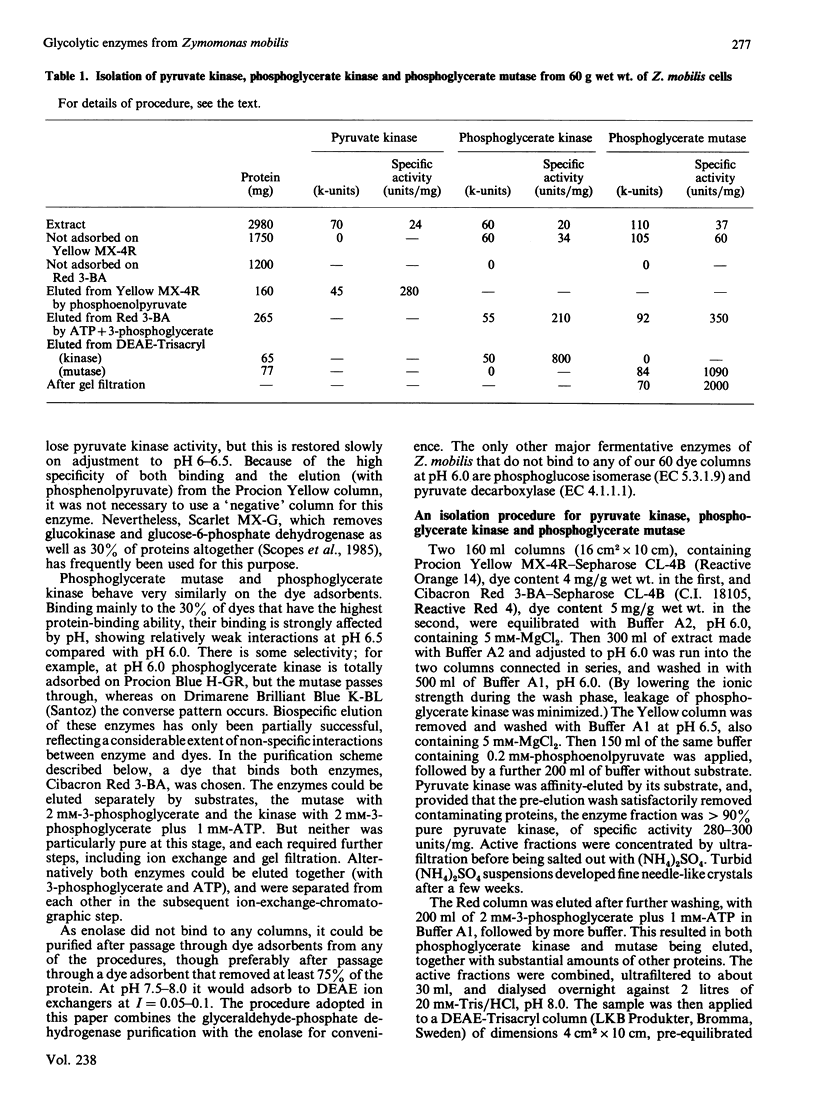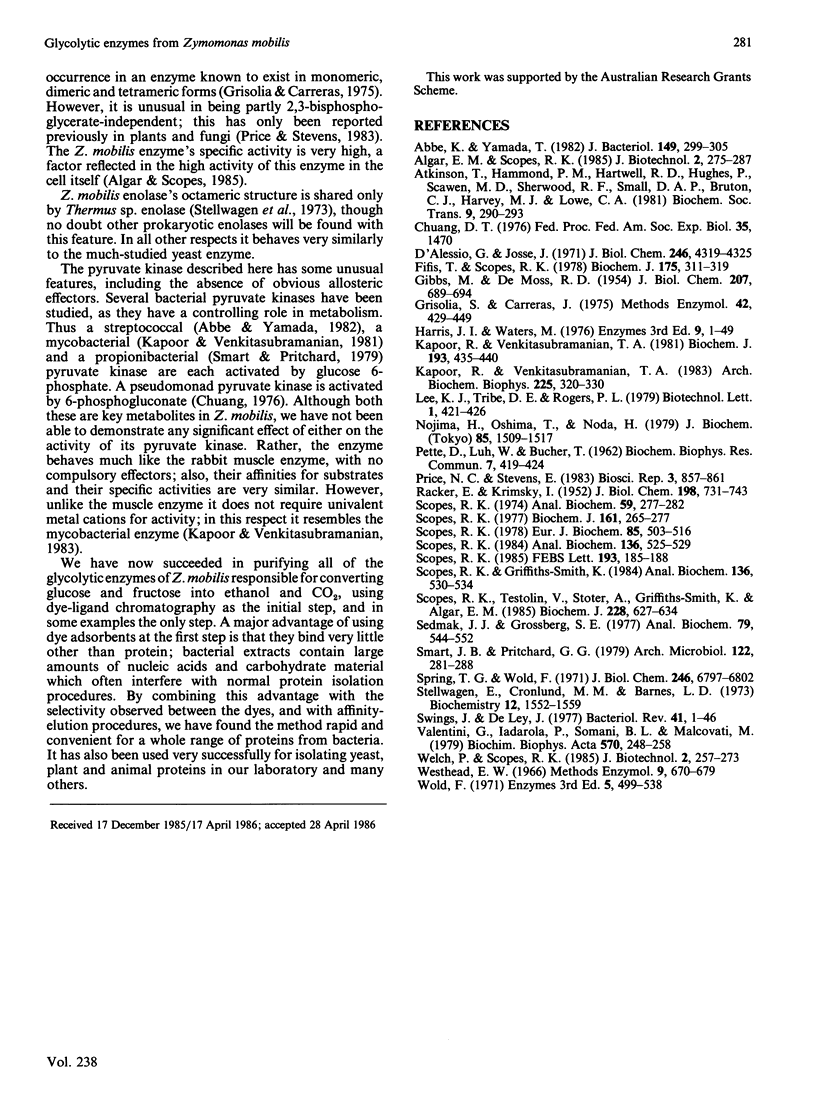Abstract
The five glycolytic enzymes glyceraldehyde-3-phosphate dehydrogenase, phosphoglycerate kinase, phosphoglycerate mutase, enolase and pyruvate kinase were each purified from extracts of Zymomonas mobilis cells, by using dye-ligand chromatography as the principal step. Two procedures, producing three and two of the enzymes respectively, are described in detail. Z. mobilis glyceraldehyde-phosphate dehydrogenase was found to be similar in most respects to the enzyme from other sources, except for having a slightly larger subunit size. Phosphoglycerate kinase has properties typical for this enzyme; however, it did not show the sulphate activation effects characteristic of this enzyme from most other sources. Phosphoglycerate mutase is a dimer, partially independent of 2,3-bisphosphoglycerate, and has a high specific activity. Enolase was found to be octameric; otherwise its properties were very similar to those of the yeast enzyme. Pyruvate kinase is unusual in being dimeric, and not requiring K+ for activity. It is not allosterically activated by sugar phosphates, having a high activity in the absence of any effectors. Some quantitative differences in the relative amounts of these enzymes, compared with eukaryotic species, are ascribed to the fact that Z. mobilis utilizes the Entner-Doudoroff pathway rather than the more common Embden-Meyerhoff glycolytic route.
Full text
PDF






Images in this article
Selected References
These references are in PubMed. This may not be the complete list of references from this article.
- Abbe K., Yamada T. Purification and properties of pyruvate kinase from Streptococcus mutans. J Bacteriol. 1982 Jan;149(1):299–305. doi: 10.1128/jb.149.1.299-305.1982. [DOI] [PMC free article] [PubMed] [Google Scholar]
- Atkinson T., Hammond P. M., Hartwell R. D., Hughes P., Scawen M. D., Sherwood R. F., Small D. A., Bruton C. J., Harvey M. J., Lowe C. R. Triazine-dye affinity; chromatography. Biochem Soc Trans. 1981 Aug;9(4):290–293. doi: 10.1042/bst0090290. [DOI] [PubMed] [Google Scholar]
- D'Alessio G., Josse J. Glyceraldehyde phosphate dehydrogenase, phosphoglycerate kinase, and phosphoglyceromutase of Escherichia coli. Simultaneous purification and physical properties. J Biol Chem. 1971 Jul 10;246(13):4319–4325. [PubMed] [Google Scholar]
- Fifis T., Scopes R. K. Purification of 3-phosphoglycerate kinase from diverse sources by affinity elution chromatography. Biochem J. 1978 Oct 1;175(1):311–319. doi: 10.1042/bj1750311. [DOI] [PMC free article] [PubMed] [Google Scholar]
- GIBBS M., DEMOSS R. D. Anaerobic dissimilation of C14-labeled glucose and fructose by Pseudomonas lindneri. J Biol Chem. 1954 Apr;207(2):689–694. [PubMed] [Google Scholar]
- Kapoor R., Venkitasubramanian T. A. Glucose 6-phosphate activation of pyruvate kinase from Mycobacterium smegmatis. Biochem J. 1981 Feb 1;193(2):435–440. doi: 10.1042/bj1930435. [DOI] [PMC free article] [PubMed] [Google Scholar]
- Kapoor R., Venkitasubramanian T. A. Purification and properties of pyruvate kinase from Mycobacterium smegmatis. Arch Biochem Biophys. 1983 Aug;225(1):320–330. doi: 10.1016/0003-9861(83)90036-x. [DOI] [PubMed] [Google Scholar]
- Nojima H., Oshima T., Noda H. Purification and properties of phosphoglycerate kinase from Thermus thermophilus strain HB8. J Biochem. 1979 Jun;85(6):1509–1517. doi: 10.1093/oxfordjournals.jbchem.a132480. [DOI] [PubMed] [Google Scholar]
- PETTE D., LUH W., BUECHER T. A constant-proportion group in the enzyme activity pattern of the Embden-Meyerhof chain. Biochem Biophys Res Commun. 1962 Jun 4;7:419–424. doi: 10.1016/0006-291x(62)90327-3. [DOI] [PubMed] [Google Scholar]
- Price N. C., Stevens E. Distinction between cofactor-dependent and -independent phosphoglycerate mutases by chromatography on Cibacron Blue-Sepharose. Biosci Rep. 1983 Sep;3(9):857–861. doi: 10.1007/BF01133784. [DOI] [PubMed] [Google Scholar]
- RACKER E., KRIMSKY I. The mechanism of oxidation of aldehydes by glyceralde-hyde-3-phosphate dehydrogenase. J Biol Chem. 1952 Oct;198(2):731–743. [PubMed] [Google Scholar]
- Scopes R. K., Griffiths-Smith K. Use of differential dye-ligand chromatography with affinity elution for enzyme purification: 6-phosphogluconate dehydratase from Zymomonas mobilis. Anal Biochem. 1984 Feb;136(2):530–534. doi: 10.1016/0003-2697(84)90257-4. [DOI] [PubMed] [Google Scholar]
- Scopes R. K. Measurement of protein by spectrophotometry at 205 nm. Anal Biochem. 1974 May;59(1):277–282. doi: 10.1016/0003-2697(74)90034-7. [DOI] [PubMed] [Google Scholar]
- Scopes R. K. Multiple enzyme purifications from muscle extracts by using affinity-elution-chromatographic procedures. Biochem J. 1977 Feb 1;161(2):265–277. doi: 10.1042/bj1610265. [DOI] [PMC free article] [PubMed] [Google Scholar]
- Scopes R. K., Testolin V., Stoter A., Griffiths-Smith K., Algar E. M. Simultaneous purification and characterization of glucokinase, fructokinase and glucose-6-phosphate dehydrogenase from Zymomonas mobilis. Biochem J. 1985 Jun 15;228(3):627–634. doi: 10.1042/bj2280627. [DOI] [PMC free article] [PubMed] [Google Scholar]
- Scopes R. K. The steady-state kinetics of yeast phosphoglycerate kinase. Anomalous kinetic plots and the effects of salts on activity. Eur J Biochem. 1978 Apr 17;85(2):503–516. doi: 10.1111/j.1432-1033.1978.tb12266.x. [DOI] [PubMed] [Google Scholar]
- Scopes R. K. Use of differential dye-ligand chromatography with affinity elution for enzyme purification: 2-keto-3-deoxy-6-phosphogluconate aldolase from Zymomonas mobilis. Anal Biochem. 1984 Feb;136(2):525–529. doi: 10.1016/0003-2697(84)90256-2. [DOI] [PubMed] [Google Scholar]
- Sedmak J. J., Grossberg S. E. A rapid, sensitive, and versatile assay for protein using Coomassie brilliant blue G250. Anal Biochem. 1977 May 1;79(1-2):544–552. doi: 10.1016/0003-2697(77)90428-6. [DOI] [PubMed] [Google Scholar]
- Spring T. G., Wold F. The purification and characterization of Escherichia coli enolase. J Biol Chem. 1971 Nov 25;246(22):6797–6802. [PubMed] [Google Scholar]
- Stellwagen E., Cronlund M. M., Barnes L. D. A thermostable enolase from the extreme thermophile Thermus aquaticus YT-1. Biochemistry. 1973 Apr 10;12(8):1552–1559. doi: 10.1021/bi00732a014. [DOI] [PubMed] [Google Scholar]
- Swings J., De Ley J. The biology of Zymomonas. Bacteriol Rev. 1977 Mar;41(1):1–46. doi: 10.1128/br.41.1.1-46.1977. [DOI] [PMC free article] [PubMed] [Google Scholar]
- Valentini G., Iadarola P., Somani B. L., Malcovati M. Two forms of pyruvate kinase in Escherichia coli. A comparison of chemical and molecular properties. Biochim Biophys Acta. 1979 Oct 11;570(2):248–258. doi: 10.1016/0005-2744(79)90145-1. [DOI] [PubMed] [Google Scholar]



